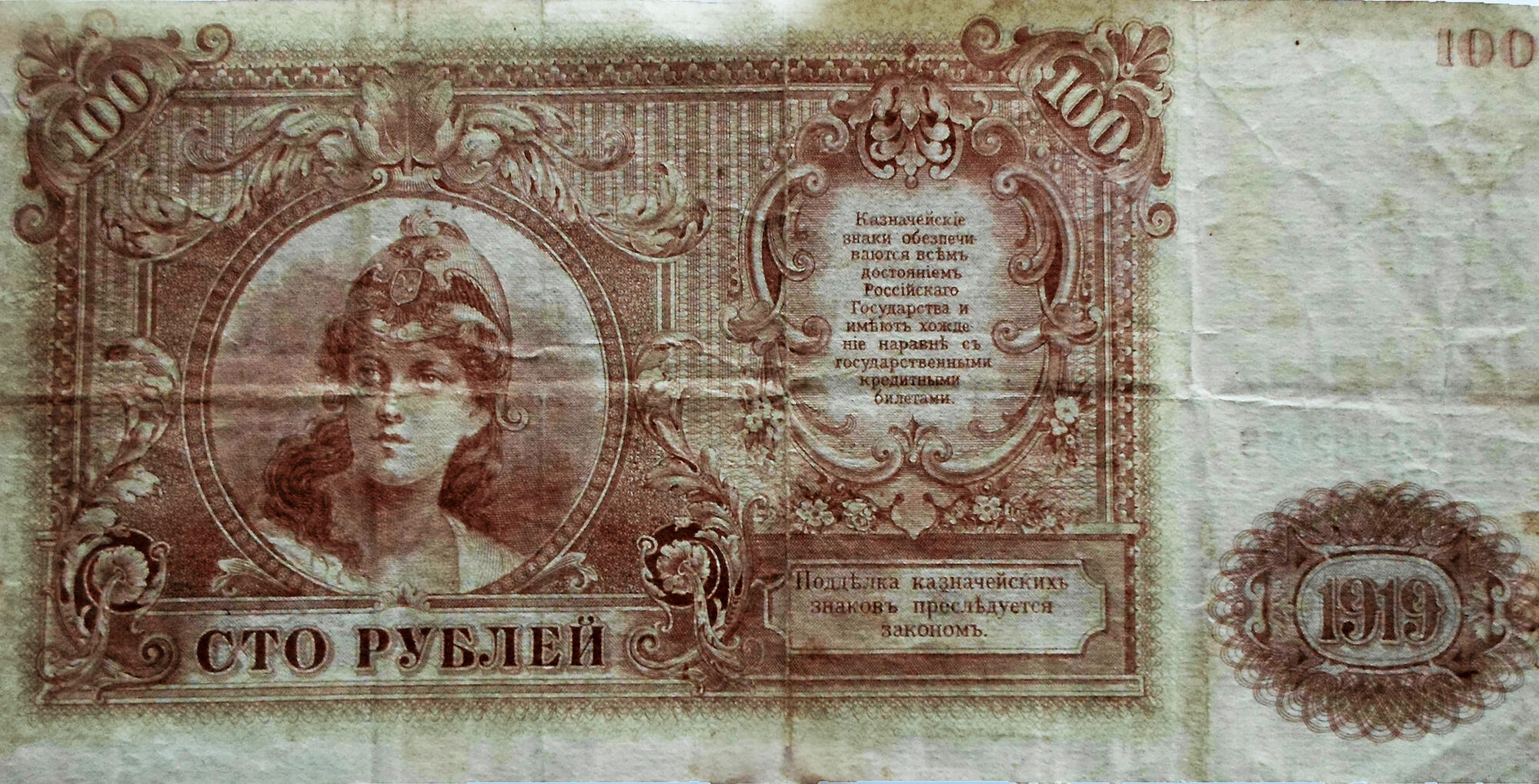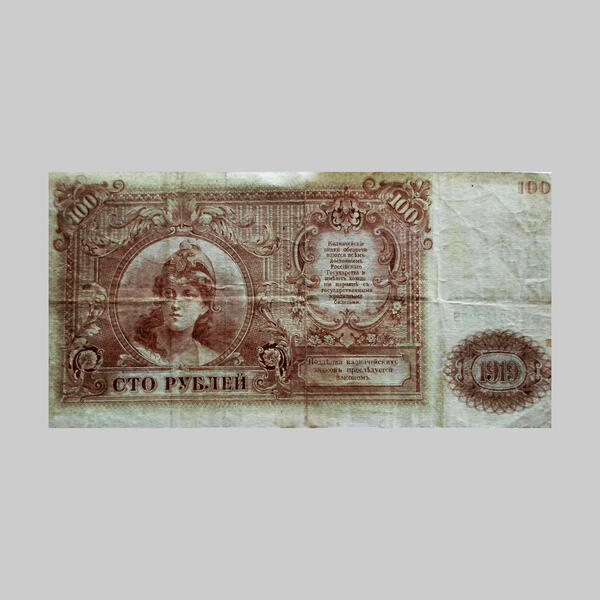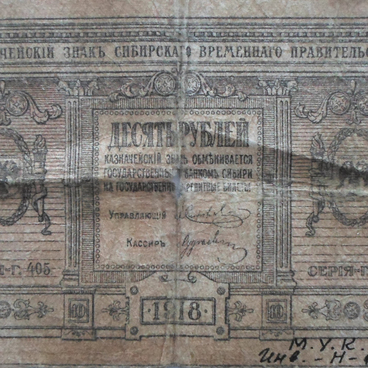The Karasuksky Regional Museum’s collection includes a paper banknote with a face value of 100 rubles. It was never in circulation - the ‘londonka’ was printed in Great Britain following a decree from the Main Command of the Armed Forces of South Russia (AFSR).
The Armed Forces of South Russia were part of the white army movement during the Civil War. They were created in January 1919, when the volunteer army and the white Cossack army merged under the command of General Anton Denikin. At various times, the AFSR also included the Crimean-Azov volunteer army, the Turkestan army, the 3rd Army Corps, the North Caucasus squadron, the Caucasian army, and the Black Sea fleet. At the end of July 1919, the Armed Forces of South Russia amounted to 160,000 troops.
In 1919 and 1920, after an unsuccessful offensive on Moscow and the Evacuation of Novorossiysk, the remaining troops of the white army retreated to Crimea, where General Pyotr Wrangel created the Russian army from those who were left. Shortly before the evacuation of Wrangel’s troops, new money which had been ordered from Crimea and printed in England arrived, with the image of a woman’s head in a helmet. The money had face values of 1, 3, 5, 50, 100 and 500 rubles. The note was issued in 1919. These Russian government treasury banknotes never entered in circulation, as by this time, the Armed Forces of South Russia, under the onslaught of the Red Army, were forced to leave the Crimean peninsula.
The ‘Londonka’ banknotes, with face values of 1, 3 and 5 rubles are very rare today, as after the Crimean offensive by the Red Army, the money was used to heat boilers in Sevastopol. In other words, the authorities did not require the banknotes.
A third of the note’s obverse is covered with a portrait of a long-haired woman in a helmet, circled within a round frame. The banknote’s face value is displayed above her, whilst there is a large water mark of ‘100’ to the right of her. The inscription on the note is 11 lines long: ‘Treasury banknotes are secured by the entire property of the Russian State and are used on a par with state credit notes.’ This inscription confirms the intention of the white movement authorities to create a fully-fledged monetary system, with gold collateral. Below this, there is a separate frame with a three-line inscription: ‘Forging treasury banknotes is forbidden by law.’
On the left of the banknote’s reverse, one third is covered by a water mark in the form of a large number ‘100’. Under the water mark there is a colored serial and serial number printed in black. On the remaining surface of the reverse, on the left, there is an eight-line inscription in an oval frame: ‘Issued by the Finance Department under the commander-in-Chief of the Armed forces of South Russia.’ The year of issuance is displayed below - 1919. On the right, a six-line inscription is displayed in an oval frame: ‘They can be exchanged for national banknotes, ’ referring to the old tsarist money, the money of the Provisional government, and kerenki banknotes.
The Armed Forces of South Russia were part of the white army movement during the Civil War. They were created in January 1919, when the volunteer army and the white Cossack army merged under the command of General Anton Denikin. At various times, the AFSR also included the Crimean-Azov volunteer army, the Turkestan army, the 3rd Army Corps, the North Caucasus squadron, the Caucasian army, and the Black Sea fleet. At the end of July 1919, the Armed Forces of South Russia amounted to 160,000 troops.
In 1919 and 1920, after an unsuccessful offensive on Moscow and the Evacuation of Novorossiysk, the remaining troops of the white army retreated to Crimea, where General Pyotr Wrangel created the Russian army from those who were left. Shortly before the evacuation of Wrangel’s troops, new money which had been ordered from Crimea and printed in England arrived, with the image of a woman’s head in a helmet. The money had face values of 1, 3, 5, 50, 100 and 500 rubles. The note was issued in 1919. These Russian government treasury banknotes never entered in circulation, as by this time, the Armed Forces of South Russia, under the onslaught of the Red Army, were forced to leave the Crimean peninsula.
The ‘Londonka’ banknotes, with face values of 1, 3 and 5 rubles are very rare today, as after the Crimean offensive by the Red Army, the money was used to heat boilers in Sevastopol. In other words, the authorities did not require the banknotes.
A third of the note’s obverse is covered with a portrait of a long-haired woman in a helmet, circled within a round frame. The banknote’s face value is displayed above her, whilst there is a large water mark of ‘100’ to the right of her. The inscription on the note is 11 lines long: ‘Treasury banknotes are secured by the entire property of the Russian State and are used on a par with state credit notes.’ This inscription confirms the intention of the white movement authorities to create a fully-fledged monetary system, with gold collateral. Below this, there is a separate frame with a three-line inscription: ‘Forging treasury banknotes is forbidden by law.’
On the left of the banknote’s reverse, one third is covered by a water mark in the form of a large number ‘100’. Under the water mark there is a colored serial and serial number printed in black. On the remaining surface of the reverse, on the left, there is an eight-line inscription in an oval frame: ‘Issued by the Finance Department under the commander-in-Chief of the Armed forces of South Russia.’ The year of issuance is displayed below - 1919. On the right, a six-line inscription is displayed in an oval frame: ‘They can be exchanged for national banknotes, ’ referring to the old tsarist money, the money of the Provisional government, and kerenki banknotes.



